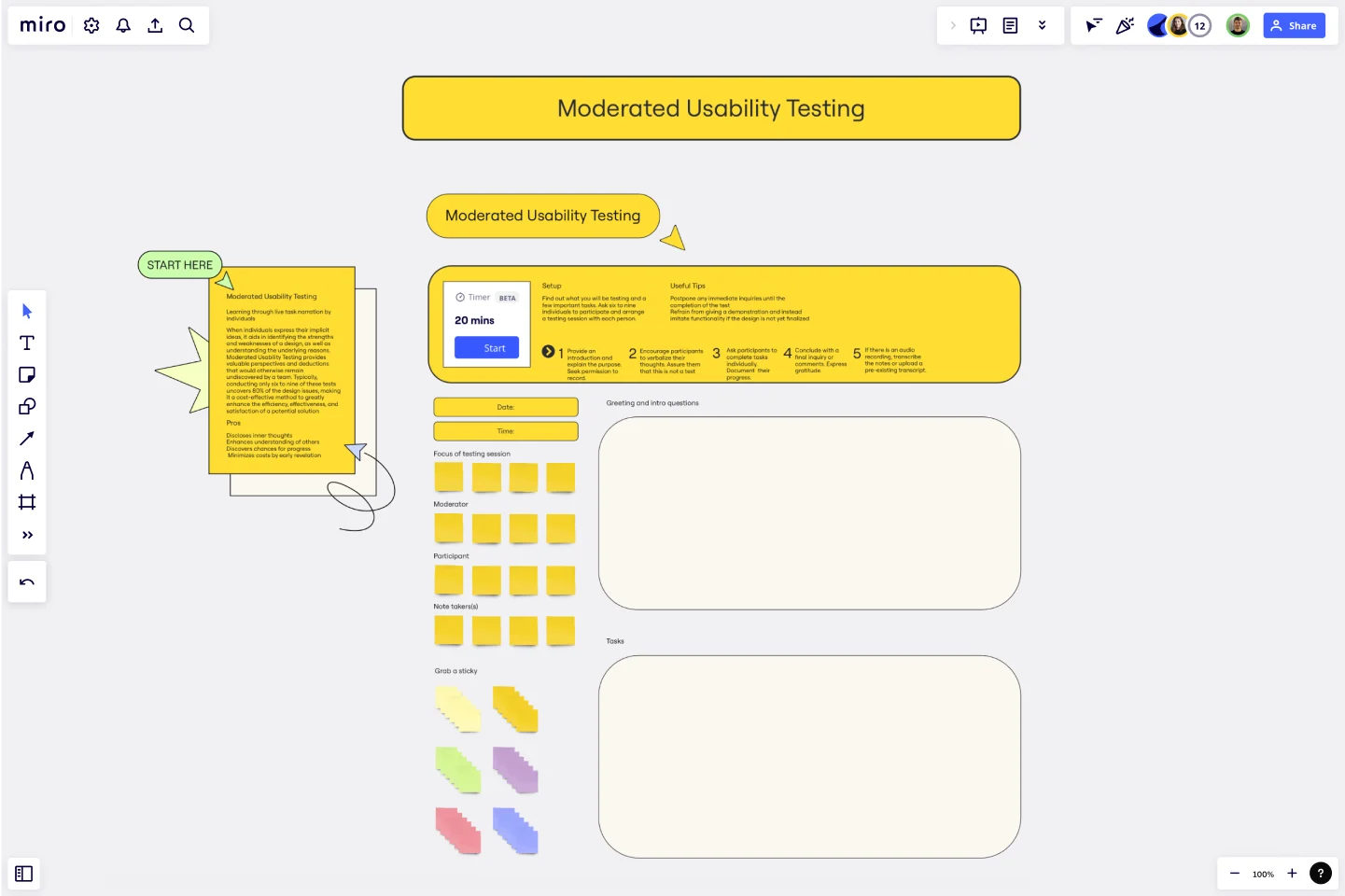Moderated Usability Testing Template
Learn through live task narration with the Moderated Usability Testing Template.
About Moderated Usability Testing Template
The Moderated Usability Testing Template helps you guide people to express their implicit ideas about a design, providing valuable insights into its strengths and weaknesses and the underlying reasons for them.
This method allows a team to gain a deeper understanding of potential issues and to identify areas where improvements can be made. By conducting only six to nine of these tests, a team can uncover as much as 80% of the design issues, making it a highly efficient and cost-effective approach for enhancing a potential solution's overall efficiency, effectiveness, and satisfaction.
Benefits of using the template
Disclose inner thoughts.
Enhance understanding of others.
Discover chances for progress.
Minimize costs by early revelation.
How to use the template in Miro
Provide an introduction and explain the purpose. Seek permission to record.
Encourage participants to verbalize their thoughts. Assure them that this is not a test.
Ask participants to complete tasks individually. Document their progress.
Conclude with a final inquiry or comments. Express gratitude.
If there is an audio recording, transcribe the notes or upload a pre-existing transcript.
Setup
Find out what you will be testing and a few important tasks.
Ask six to nine people to participate and arrange a testing session with each person.
Useful tips
Postpone any immediate inquiries until the completion of the test.
Refrain from giving a demonstration and instead imitate functionality if the design is not yet finalized.
Get started with this template right now.
Pass the Paper
Collaborative brainstorming is an excellent method to facilitate a group of individuals in generating a diverse range of innovative concepts related to a specific problem. By encouraging participants to build upon each other's ideas, the process allows for rapid evolution and unexpected transformations. This collaborative approach, known as Round Robin, emphasizes collective authorship, with each person contributing their unique perspective. The ultimate outcome is a collection of ideas that surpasses the imagination of any individual.
Plant Care App Wireframe Template
Works best for:
Wireframe, UX, Design
The Plant Care App Wireframe template provides a multi-screen app wireframe along with all the necessary design pages to get started. You can easily customize the wireframe to meet the specific needs of your client or personal project. Add, remove, or adjust screens to create a smooth user flow, and personalize the design by modifying colors, typography, and layouts. Leverage our AI-powered features to further enhance your app design.
Look Mock Analyze Template
Works best for:
Design, Desk Research, Product Management
Doing your homework (aka, the research) is a key step in your design process, and the Look, Mock, Analyze approach helps you examine, structure, and streamline that step. With this powerful tool you’ll be able to identify your strengths and weaknesses, what you did right or wrong, and whether you spent time efficiently. Our Look, Mock, Analyze template makes it so easy for you to discover inspiration, mock up designs, and get feedback — you can start by setting up your board in less than a minute.
Spider Chart Template
Works best for:
Design
Spider Charts (or star plots) prioritize thoughts and ideas by importance. They help visualize complex information with significant items in the center and less important items progressively farther from it. Radar spider charts help understand relationships between information for better decision-making.
Service Blueprint by Daily Creations
Works best for:
Research & Design
Enhance your service design with the Service Blueprint template. This tool maps out the customer journey and backstage processes, helping you visualize and improve service delivery. It's perfect for aligning teams, identifying inefficiencies, and ensuring a seamless customer experience. Use this template to create a detailed roadmap of your service processes, fostering collaboration and strategic improvements in service design.
Service Blueprint by Hyperact
Works best for:
Research & Design
The Service Blueprint template is perfect for visualizing the orchestration of service components. It maps out frontstage and backstage elements, helping you analyze and enhance customer experiences. Use this template to align teams, identify pain points, and streamline processes, ensuring a seamless service delivery. It's ideal for creating a shared understanding of service dynamics among stakeholders and collaborators.
